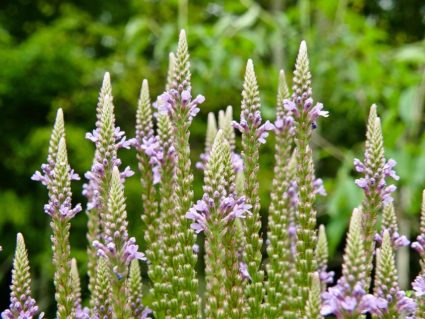
Blue vervain (Verbena hastata, Verbenaceae). This plant probably tops many people’s ‘love that plant’ list. Yes, mine included. It is handsome and graceful and sturdy and what a gorgeous sight with many blooming at the same time covering an expanse of bog or swamp.
What I find interesting is that it seems our current use of Blue vervain as medicine is derived from its European relative Verbena officinalis (Vervain, Simpler’s joy and others). And while Verbena officinalis is easy enough to grow, the native here is the preferred plant. I don’t see that very often, where a famed European medicinal plant is usurped by the local. Well, bravo, and personally I think both plants work rather well.
And what is that use? As a nervous system tonic (a neurotrophorestorative to folks like me who just like long medical-sounding words). I like it better as a nerve tonic rather than for acute ‘nerves’. I have seen it help many people, often in formula with nervine cousins such as California poppy (Eschscholtzia) Hops (Humulus), Jamaican dogwood (Piscidia), Skullcap (Scutellaria) and similar. Each of these is different and by mixing and matching, one can come up with an impressive individualistic formula.
I use it specifically for over-thinking worrywart types, that is to say Pitta-on-fire. You know the type, always planning, and

having a hard time accepting changes to the schedule. Or people who cannot help but work and push and work and become obstinately cranky. They may need to relearn how to breath and listen, but this medicine can help too. It seems to relax what looks like excessive neurotransmitter firing.
Now we can divide worriers into two types here (Vata and Pitta for you in the Ayurvedic know). I don’t see this as helpful for the vata worrier, whose mind will become very scattered when things go awry and may go blank or will fill with lots of fog, fizz and fuzz. The type I see it helpful for is more the typical Pitta pattern. That is when plans change abruptly, say a flat tire, they will get all busybody like and tell everyone what to do, and do I see some anger there? Or they will indulge in heaping cupfuls of self-recrimination (“I knew we should’ve taken my car!”)
It is helpful to take regularly, something like ½-2 dropperfuls (.60 ml-2.5 ml) 2-4 times daily. At first the person may not notice a difference, but ask again a few weeks after taking it and they may say they feel as if their feathers are not as easily ruffled. I don’t know if I’ve yet seen very negative reactions to this plant medicine, just some neutral ones (as in, it doesn’t seem to do anything).
I tincture the fresh (or fresh dried) inflorescence (flowertops) and leaves. It is common around here, but still, I am careful not to take too much from any one area, as I do not want to disturb the beauty quotient of where it grows.
I also use the dried leaves and inflorescences as tea. If it is dried too slowly the leaves get a blackish hue, which I am not sure is a problem, but I use a dehydrator where the leaves stay green and some of the flowers keep some of their purple.
It is bitter tasting, though less biting then some.
I hope this paints a helpful portrait. Try this plant if you have not. You know who to give it to.



Hi there,
Thanks for this informative post. You say that “I don’t see this as helpful for the vata worrier, whose mind will become very scattered when things go awry”. So could you tell me which herb would be helpful for this type? (which I think I am).
Kat
I read somewhere that the root of V. hastata is used, vs the herb? Have you ever tried it?